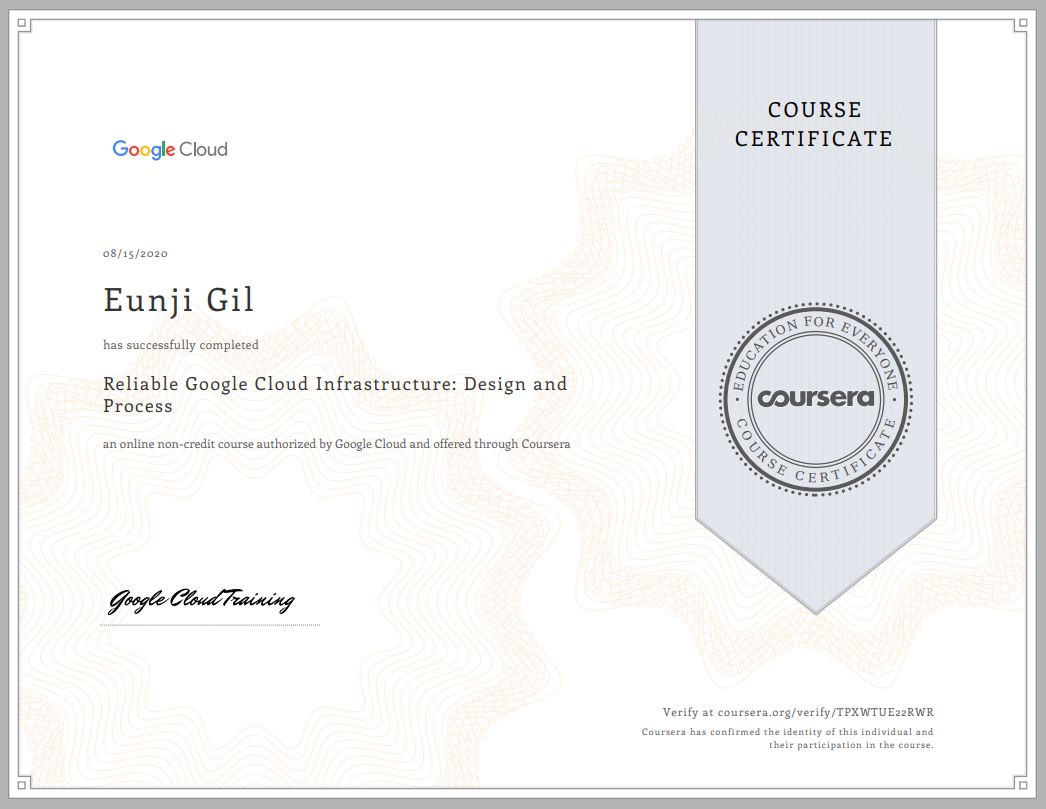
방학 때 PCA와 ACE를 모두 취득하겠다고 다짐했지만
시험이 1주 미뤄진 관계로 다음주와 9월초에 두 개의 시험을 보게 될 것 같다. 아직 부족한 것 같았는데 잘 된 것 같기도 하다..ㅎ
그래서 코세라를 하나 더 수료했다는 이야기..!
이번 코세라는 케이스 스터디가 많아서 좋았다.
- Describe users in terms of roles and personas.
- Write qualitative requirements with user stories.
- Write quantitative requirements using key performance indicators (KPIs)
- Evaluate KPIs using SLOs and SLIs.
- Determine the quality of application requirements using SMART criteria.
- Decompose monolithic applications into microservices.
- Recognize appropriate microservice boundaries.
- Architect stateful and stateless services to optimize scalability and reliability.
- Implement services using 12-factor best practices.
- Build loosely coupled services by implementing a well-designed REST architecture.
- Design consistent, standard RESTful service APIs.
- Automate service deployment using CI/CD pipelines.
- Leverage Cloud Source Repositories for source and version control.
- Automate builds with Cloud Build and build triggers.
- Manage container images with Google Container Registry.
- Create infrastructure with code using Deployment Manager and Terraform.
- Choose the appropriate Google Cloud data storage service based on use case, durability, availability, scalability and cost.
- Store binary data with Cloud Storage.
Store relational data using Cloud SQL and Spanner. - Store NoSQL data using Firestore and Cloud Bigtable.
- Cache data for fast access using Memorystore.
- Build a data warehouse using BigQuery.
- Design VPC networks to optimize for cost, security, and performance.
- Configure global and regional load balancers to provide access to services.
- Leverage Cloud CDN to provide lower latency and decrease network egress.
- Evaluate network architecture using the Cloud Network Intelligence Center.
- Connect networks using peering and VPNs.
- Create hybrid networks between Google Cloud and on-premises data centers using Cloud Interconnect.
- Choose the appropriate Google Cloud deployment service for your applications.
- Configure scalable, resilient infrastructure using Instance Templates and Groups.
- Orchestrate microservice deployments using Kubernetes and GKE.
- Leverage App Engine for a completely automated platform as a service (PaaS)
- Create serverless applications using Cloud Functions.
- Design services to meet requirements for availability, durability, and scalability.
- Implement fault-tolerant systems by avoiding single points of failure, correlated failures, and cascading failures.
- Avoid overload failures with the circuit breaker and truncated exponential backoff design patterns.
- Design resilient data storage with lazy deletion.
- Analyze disaster scenarios and plan for disaster recovery using cost/risk analysis.
- Design secure systems using best practices like separation of concerns, principle of least privilege, and regular audits.
- Leverage Cloud Security Command Center to help identify vulnerabilities.
- Simplify cloud governance using organizational policies and folders.
- Secure people using IAM roles, Identity-Aware Proxy, and Identity Platform.
- Manage the access and authorization of resources by machines and processes using service accounts.
- Secure networks with private IPs, firewalls, and Private Google Access.
- Mitigate DDoS attacks by leveraging Cloud DNS and Cloud Armor.
- Manage new service versions using rolling updates, blue/green deployments, and canary releases.
- Forecast, monitor, and optimize service cost using the Google Cloud pricing calculator and billing reports and by analyzing billing data.
- Observe whether your services are meeting their SLOs using Cloud Monitoring and Dashboards.
- Use Uptime Checks to determine service availability.
- Respond to service outages using Cloud Monitoring Alerts.
8개의 댓글
Choosing a trustworthy Gurgaon Escorts Service can be challenging, but doing proper research helps you find the best match. These services prioritize your safety and satisfaction, providing verified companions for your peace of mind. The Gurgaon Escorts Service industry is evolving to offer more personalized and professional experiences than ever before.
Are you looking for some fun in city, come with us and enjoy fun.
https://www.jalandharescort.co.in/
Thanks for sharing the best information. I love it.
https://www.escortserviceludhiana.co.in/
Thanks you for this awesome post. it’s very informative blog thanks for sharing with us.
https://ludhianaescort.co.in/
very nice and good services gurleen kaur in city Jalandhar.
https://www.gurleen.co.in
very nice and good services gurleen kaur in city Jalandhar.
https://www.gurleen.co.in







To ensure your complete comfort and convenience, our professional Call Girl In Agra are readily available for both private incall sessions (at their secure location) and convenient outcall bookings (at your preferred spot). This flexibility makes it incredibly simple and effortless for you to access and fully enjoy our top-level, premium quality services exactly as you prefer them.